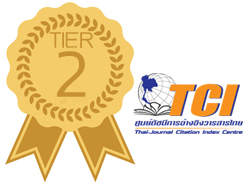การใช้คำปนภาษาอังกฤษในละครโทรทัศน์เรื่องยูปริ๊นซ์
คำสำคัญ:
คำปนภาษา, การปรับตามภาษาแม่, แรงจูงใจในการปนภาษาบทคัดย่อ
ในปัจจุบันนี้ปรากฏการณ์การใช้คำปนภาษาอังกฤษได้ปรากฏให้เห็นในสื่อไทยหลายประเภท วัตถุประสงค์ของการใช้คำปนภาษาอังกฤษไม่ได้เป็นแค่เพียงเครื่องมือที่ใช้เพื่อการสื่อสารเท่านั้นแต่ยังเป็นเสมือนสัญลักษณ์ในการแสดงออกถึงความทันสมัยด้วย บทบาทของการใช้คำปนภาษาอังกฤษสามารถพบได้มากขึ้นในละครโทรทัศน์ไทย ซึ่งเป็นภาพสะท้อนการใช้ภาษาในชีวิตจริงที่แสดงให้เห็นว่าคนไทยได้ใช้คำปนภาษาอังกฤษมากขึ้นในการสนทนา งานวิจัยชิ้นนี้มีวัตถุประสงค์ในการจัดทำขึ้นเพื่อสำรวจลักษณะรูปแบบทางภาษาและแรงจูงใจในการใช้คำปนภาษา ตลอดจนถึงการตรวจสอบความหมายและลักษณะของคำผ่านกระบวนการวิเคราะห์การปรับตามภาษาแม่ โดยเก็บชุดข้อมูลในการวิเคราะห์จากบทสนทนาในละครโทรทัศน์วัยรุ่นเรื่องยูปริ๊นซ์ ผลการวิจัยพบว่าคำปนภาษาอังกฤษที่ถูกใช้มากที่สุดนั้นเป็นระดับหน่วยคำ ส่วนในกระบวนการปรับความหมายตามภาษาแม่พบว่าการตัดคำถูกใช้มากที่สุด และการใช้คำที่มีความหมายเจาะจงเป็นแรงจูงใจอันดับแรกของการใช้คำปนภาษาจากบทสนทนาในละครโทรทัศน์เรื่องนี้ การใช้คำปนภาษาในละครเรื่องยูปริ๊นซ์นั้น แสดงให้เห็นถึงการเปิดรับการใช้คำปนภาษาอังกฤษและการนำมาปรับใช้เพื่อการสนทนาในกลุ่มเด็กวัยรุ่นไทยตลอดจนถึงการนำมาใช้ร่วมกับกลุ่มผู้มีภูมิหลังทางสังคมและมีการศึกษาในระดับใกล้เคียงกัน
เอกสารอ้างอิง
2. Kannaovakun P, Gunther AC. The mixing of English and Thai in Thai television program. Manusya:
Journal of Humanities 2003; 6: 66-80.
3. Ho JWY. Code-mixing: linguistic form and socio-cultural meaning [Internet] 2007 [cited 2017 Jul 22].
Available from: http://www.educ.utas.edu.au/users/tle/journal/issues/2007/21-2.pdf.
4. Muysken P. Bilingual Speech: A typology of code-mixing. Cambridge: Cambridge University Press; 2000.
5. Bhatia TK, Ritchie WC. The bilingual mind and linguistic creativity. Journal of Creative Communications
2008; 3(1): 5-21.
6. Thadphoothon J. Characteristics of the use of English by Thai academics: A Preliminary Investigation.
Suthiparithat 2009; 23(71): 107-32.
7. Lee J. A Corpus-Based Analysis of Mixed Code in Hong Kong Speech. International Conference on Asian
Language Processing (IALP); 2012. p.165-68.
8. O’grady WD, Archibald J. Contemporary linguistic analysis: an introduction. 4thed. Toronto:
Pearson Education Canada; 2000.
9. Papijit W. Thai-English code-Mixing in Hormones the series [Master’s Thesis]. Bangkok:
National Institute of Development Administration; 2013.
10. Li DCS. Cantonese-English code-switching research in Hong Kong a Y2K review.
World Englishes. 2000; 19(3): 305-22.
11. Jaspal R. Language and social identity: a psychosocial approach. Psychtalk.
2009; 64: 17-20.
12. Reyes I. Functions of code switching in schoolchildren's conversations. Bilingual Research
Journal. 2004; 28(1): 77-98.
13. Hoffmann C. An introduction to bilingualism. London: Longman; 1991.




